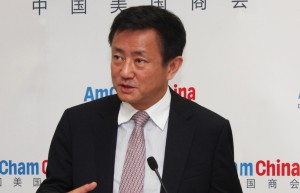
Fan Gang, director, National Economic Research Institute, suggested China's economy will be strong for several years.
Despite the fact that China’s economy isn’t living up to predictions this year, the overall picture for the country is bright even as it faces significant challenges to its growth, one of China’s leading economists posited yesterday at the Global Automotive Forum in Wuhan, China.
Fan Gang, director, National Economic Research Institute, suggested China’s economy will grow at a slightly slower pace, 7.3% rather than the 7.5% rate projected by the central government at the beginning of the year. However, a growth rate of between 7% and 8% is more manageable and more sustainable for what is now the world’s second-largest economy behind the United States’.
In fact, a hotter rate of growth would be problematic, Fan said. If the economy grew faster than 9%, inflation would become a problem for the country as a whole, while a growth rate of better than 10% could create an “asset bubble” either in real estate or elsewhere in the economy.
The 7% to 8% rate of growth is quite sustainable over a long period and quite substantial, given the overall size of the Chinese economy today, he said. South Korea’s economy has consistently grown at a rate of about 7% year since the early 1980s and there is no reason why China can’t follow a similar path, Fan said.
“China’s actually returning to a more normal rate of growth,” he said.
Fan, who also serves as an economic advisor to China’s Communist led central government, noted that China’s economy also has ample room to grow. While China is now the second-largest economy in the world by gross domestic product, its per capita income – a very different measure of economic well being – is only 13% of that of the U.S. China’s wage earners save up to 50% income each year.
In short, not only are they expected to make more in the future, but also Chinese officials are working on trying to get them to spend more of it.
The government is hoping to persuade Chinese wage earners to reduce their savings rate by roughly 1% per year. Even a small reduction in the savings rate and corresponding increase in consumption would produce a substantial stimulus, Fan said.
“The potential growth rate was always 7% to 8%. Even 6% is still high growth. Personally I’m optimistic will maintain normal high growth,” he said.
Fan also indicated that China has ample reserves to continue to “build for the future” by spending money on infrastructure projects. One project proposed recently is by Chinese President Xi Jinping is a 7,000-kilometer highway from Beijing to Moscow.
(China plays critical role in GM’s intelligent vehicle development. For more, Click Here.)
“We have an abundance of capital,” he added. “Investment in infrastructure will remain high because of savings rate.”
Fan also observed China has already had what he described as a “soft landing” in the wake of the global financial crisis in 2008 and 2009.
(Click Here for details on Ford’s attempt to secure fifth consecutive SEMA truck crown.)
“There was a real estate bubble in the ‘tier one’ cities, such as Beijing and Shanghai, huge mega cities with 25 million people. But the real estate bubble and resulting troubles did not spread into the second- and third-tier cities where the housing market remained bullish but stable and prices never escalated dramatically. Nationwide, we have soft landed in the real estate sector,” he said.
China has its share of challenges, but commentators and pundits from outside China tend to underestimate the country’s resiliency and stability. China also has a well-deserved reputation for copying, but Fan predicted that the Chinese economy will become more innovative as the country’s heavy investment in education at all levels helps create new paths in technology and organization.
(To see more about Honda’s new HR-V’s arrival at L.A. Auto Show, Click Here.)
China has already becoming something of a leader and innovator in e-commerce, according to other speakers during the conference.
Fan, however, said China’s financial sector is still largely underdeveloped. The machinery or heavy industry sector needs reform, the agricultural sector absorbs too much manpower and local government debt is too high: all challenges expected to be addressed in the coming years. The environmental concerns of China’s growing middle class are another significant is also a significant challenge.
In fact, the environmental challenges could turn into an economic hurdle if they are not addressed, Fan cautioned. But the future is still very bright. Despite its growth on a per capita basis, China still has a long ample room for new development.
“Imagine how big the market will become if we catch up with Russia,” he noted by way of comparison. “China’s story is still in the making we still have huge potential.”
